6 lettuce-free recipes that will make you love salad
Tired of leafy greens? These flavorful, nutritious dishes will be right up your alley.
Updated on May 18, 2022
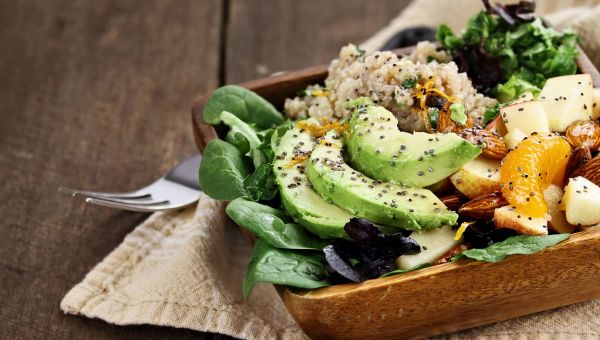
Your salad can be more than a big bowl of leafy greens. In fact, a healthy and filling salad doesn’t have to include lettuce at all. You can toss tasty mix-ins like nuts and cheese with your favorite fruits, veggies, and whole grains to create tasty, satisfying, and 100 percent lettuce-free meals.
Worried about missing out on necessary nutrients? Don’t be! Foods… Show More
Your salad can be more than a big bowl of leafy greens. In fact, a healthy and filling salad doesn’t have to include lettuce at all. You can toss tasty mix-ins like nuts and cheese with your favorite fruits, veggies, and whole grains to create tasty, satisfying, and 100 percent lettuce-free meals.
Worried about missing out on necessary nutrients? Don’t be! Foods like tomatoes, cucumbers, quinoa, and avocado are loaded with the essentials.
Show Less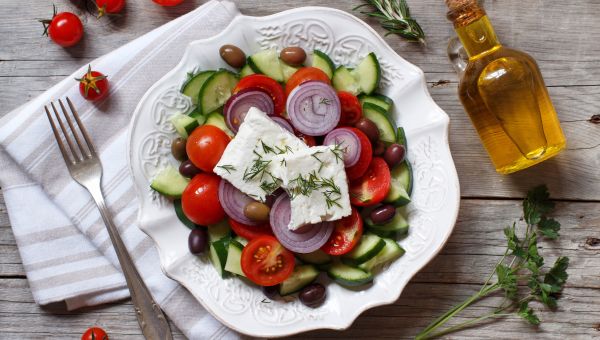
Greek salad
This tangy, low-calorie salad combines a few flavorful ingredients for a taste of the Mediterranean in the comfort of your own home.
Start with a whole cucumber, which contains just 45 calories, for a crunchy base. Then, add 1 cup of chopped tomatoes. It contains 30 calories and is loaded with… Show More
This tangy, low-calorie salad combines a few flavorful ingredients for a taste of the Mediterranean in the comfort of your own home.
Start with a whole cucumber, which contains just 45 calories, for a crunchy base. Then, add 1 cup of chopped tomatoes. It contains 30 calories and is loaded with vitamins A and C, which promote a healthy immune system and provide potassium, necessary for proper nerve and muscle function. Toss in some sliced red onion for zing and fiber.
Once you mix your main ingredients, sprinkle in 1 tablespoon of crumbled feta cheese (74 calories) and a small handful of Kalamata olives (84 calories). A squeeze of lemon and dusting of dried oregano are all you need to top it off.
Show Less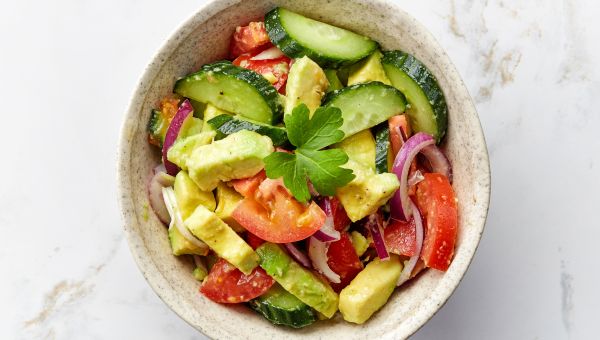
Tomato and avocado salad
Ditch the bread to enjoy the flavors of a classic deli sandwich with a fraction of the sodium, fat, and calories.
Start by combining a chopped tomato and cucumber slices with chunks of avocado. Avocado contains fiber, vitamin K, and lots of healthy fats, which can help reduce “bad” LDL cholesterol… Show More
Ditch the bread to enjoy the flavors of a classic deli sandwich with a fraction of the sodium, fat, and calories.
Start by combining a chopped tomato and cucumber slices with chunks of avocado. Avocado contains fiber, vitamin K, and lots of healthy fats, which can help reduce “bad” LDL cholesterol levels and lower your heart disease risk. Avocados are high in calories (322 per fruit) so slice no more than half into your bowl.
Sprinkle in chopped scallions, a dash of kosher salt and black pepper, and a splash of balsamic vinaigrette before giving your salad a good, gentle stir.
Show Less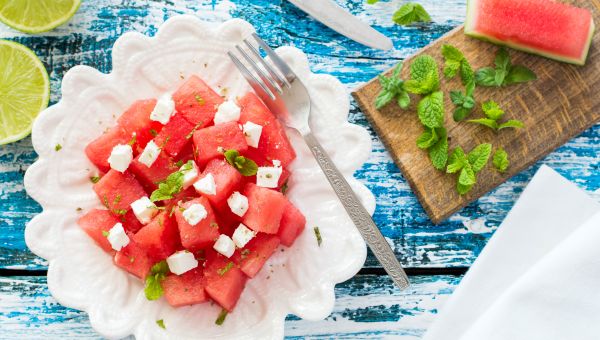
Watermelon and feta summer salad
Who said salads had to be savory? This light and refreshing recipe can be enjoyed at snack time or topped with a few grilled shrimp and eaten as a complete meal.
The star of this salad is juicy watermelon, which contains vitamins A and C and has just 50 calories per cup. Just add a small handful of… Show More
Who said salads had to be savory? This light and refreshing recipe can be enjoyed at snack time or topped with a few grilled shrimp and eaten as a complete meal.
The star of this salad is juicy watermelon, which contains vitamins A and C and has just 50 calories per cup. Just add a small handful of fresh chopped mint, a tablespoon of crumbled feta, and a squeeze tangy lime juice. Then, dig in.
Show Less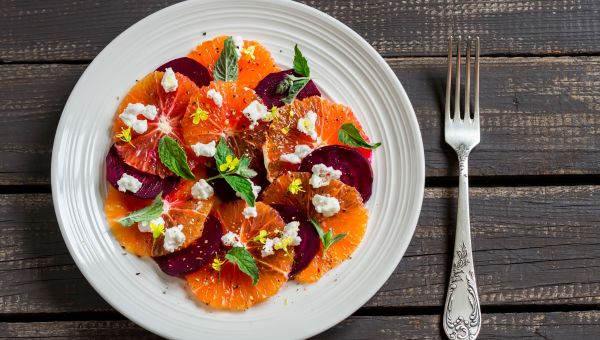
Crunchy beet salad
This salad comes together with almost no effort—and tastes great!
Feel free to boil your own beets, but the canned kind work just as well. Just give them a good rinse to get rid of any excess sodium. A cup of beets contains only 60 calories, but also delivers fiber, a bit of protein, and potassium,… Show More
This salad comes together with almost no effort—and tastes great!
Feel free to boil your own beets, but the canned kind work just as well. Just give them a good rinse to get rid of any excess sodium. A cup of beets contains only 60 calories, but also delivers fiber, a bit of protein, and potassium, which promotes healthy muscle and nerve function and a regular heartbeat.
Layer your beets with tangerine slices, a tablespoon of goat cheese, a few walnut halves, and a drizzle of balsamic vinegar. One small tangerine comes to fewer than 50 calories. Walnuts contain heart-healthy fats, but the calories in nuts add up fast, so go easy. The same is true for creamy goat cheese.
Show Less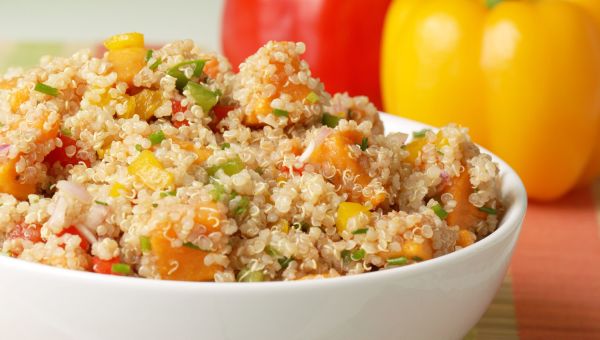
Colorful vegetable and quinoa salad
Shake up your salad routine by filling your bowl with 100 percent whole grains, like quinoa or brown rice.
Measure out 1 cooked cup of quinoa, which is loaded with protein, fiber, and manganese. Next, chop up and toss in your favorite veggies and beans; red onions, black beans, and bell peppers… Show More
Shake up your salad routine by filling your bowl with 100 percent whole grains, like quinoa or brown rice.
Measure out 1 cooked cup of quinoa, which is loaded with protein, fiber, and manganese. Next, chop up and toss in your favorite veggies and beans; red onions, black beans, and bell peppers make for great additions. Black beans provide lots of fiber and iron, while bell peppers and onions both contain vitamin C. Top your mixture with a salt, pepper, a drizzle of extra virgin olive oil and chopped cilantro or parsley if desired.
Show Less
Fiesta bean salad
Beans are good sources of protein, fiber, and iron. A 1/2-cup serving of black, garbanzo, or red kidney beans offers about 7 grams of protein and more than 10 percent of the daily recommended amount of iron.
Toss your favorite legumes with a bit of diced onion and splashes of vinegar and olive oil.… Show More
Beans are good sources of protein, fiber, and iron. A 1/2-cup serving of black, garbanzo, or red kidney beans offers about 7 grams of protein and more than 10 percent of the daily recommended amount of iron.
Toss your favorite legumes with a bit of diced onion and splashes of vinegar and olive oil. Spices and herbs can also add flavor without extra calories, sodium, and saturated fats of some other salad ingredients. Dill, thyme, oregano, cilantro, and parsley pair well with beans, but don’t be afraid to experiment.
Show Less
NIH Office of Dietary Supplements. Vitamin A and Carotenoids: Fact Sheet for Health Professionals. March 23, 2022. Accessed May 12, 2022.
NIH Office of Dietary Supplements. Vitamin C: Fact Sheet for Consumers. March 26, 2021. Accessed May 12, 2022.
NIH Office of Dietary Supplements. Vitamin K: Fact Sheet for Health Professionals. March 29, 2021. Accessed May 12, 2022.
American Heart Association. Polyunsaturated Fats. June 1, 2015. Accessed May 12, 2022.
American Heart Association. Monounsaturated Fat. June 1, 2015. Accessed May 12, 2022.
American Heart Association. Go Nuts (But just a little!) November 1, 2021. Accessed May 12, 2022.
American Heart Association. Hyperkalemia (High Potassium). October 31, 2016. Accessed May 12, 2022.
MedlinePlus. Potassium. October 20, 2017. Accessed May 12, 2022.
MedlinePlus. Cooking without salt. May 26, 2020. Accessed May 12, 2022.
Harvard TH Chan School of Public Health. Fiber. 2022. Accessed May 12, 2022.
More On


video
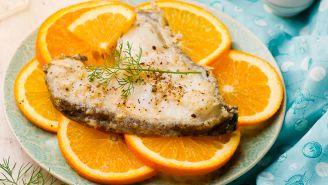
article

slideshow


video


video
